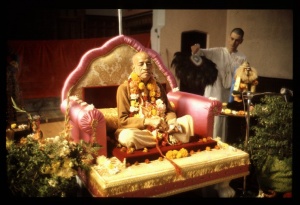CC Madhya 18.3 (1975)

A.C. Bhaktivedanta Swami Prabhupada
TEXT 3
- ei-mata mahāprabhu nācite nācite
- 'āriṭ'-grāme āsi' 'bāhya' haila ācambite
SYNONYMS
ei-mata—in this way; mahāprabhu—Śrī Caitanya Mahāprabhu; nācite nācite—dancing and dancing; āriṭ-grāme—in the village known as Āriṭ-grāma; āsi,—coming; bāhya—sense perception; haila—there was; ācambite—suddenly.
TRANSLATION
Śrī Caitanya Mahāprabhu danced in ecstasy, but when He arrived at Āriṭgrāma, His sense perception was awakened.
PURPORT
Āriṭ-grāma is also called Ariṣṭa-grāma. Śrī Caitanya Mahāprabhu understood that in that village, Ariṣṭāsura was killed by Śrī Kṛṣṇa. While there, He inquired about Rādhā-kuṇḍa, but no one could tell Him where it was. The brāhmaṇa accompanying Him could also not ascertain its whereabouts. Śrī Caitanya Mahāprabhu could then understand that the holy places known as Rādhā-kuṇḍa and Śyāma-kuṇḍa were at that time lost to everyone's vision. He therefore discovered Rādhā-kuṇḍa and Śyāma-kuṇḍa, which were two reservoirs of water in two paddy fields. Although there was very little water, Śrī Caitanya Mahāprabhu was omniscient and could understand that formerly these two ponds were called Śrī Rādhā-kuṇḍa and Śyāma-kuṇḍa. In this way Rādhā-kuṇḍa and Śyāma-kuṇḍa were discovered.